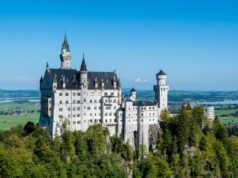Das Wichtigste in Kürze
What is the significance of Hohenschwangau Castle?
Hohenschwangau Castle was the childhood home of the King Ludwig II of Bavaria and the birthplace of his son, Crown Prince Rupprecht of Bavaria.
What is the architecture of Hohenschwangau Castle like?
The castle is constructed mainly in the Romantic style of architecture, with its walls and towers featuring ornate stonework and colorful frescoes. Find out here which other styles influenced the architecture…
What are some of the attractions inside Hohenschwangau Castle?
The castle features several attractions, including the King’s Bedroom, the Throne Room, the Hall of Ancestors, and the Hall of Knights. Additionally, visitors can explore the castle’s gardens and courtyards. Here you can find out more about the castle and it’s attractions…
Hohenschwangau Castle is a 19th-century palace in the town of Hohenschwangau, near Füssen in southwest Bavaria, Germany. The Bavarian Kings used it as a summer residence. It is less well known than its neighbor, Neuschwanstein, but nonetheless worth a visit.
Additionally, if you ever visit Schwangau in Germany, make sure to check out the beautiful Schwangau castle, built by King Maximilian II.
The history of Hohenschwangau – the King’s Castle

Hohenschwangau Castle has a long and rich history that dates back to the Middle Ages. The knights of Schwangau built it in the 12th century as a fortress and residence for the local nobility.
Keyfactbox
In the 19th century, King Maximilian II of Bavaria, who was the father of King Ludwig II, acquired the castle. King Maximilian II had it renovated and transformed it into a summer residence for his family.
After King Maximilian II’s death, his son, King Ludwig II, inherited the castle and continued to use it as a summer residence. He had enjoyed hikes in the nearby countryside in his youth, and treasured the memories. King Ludwig II was a patron of the arts and a lover of all things romantic and fantastic. He had a great interest in the legend of the “Lohengrin” which inspired the decor and design of the king’s castle.
King Ludwig II was also responsible for the construction of several other castles in Bavaria, including Linderhof Palace and Herrenchiemsee Castle. His extravagant and lavish lifestyle, and his love for the arts and literature, afforded him the nickname “Fairy Tale King”.
Hohenschwangau Castle continued to be used as a royal residence until the death of King Ludwig II in 1886. After his death, the castle became accessible for the public and turned into a popular tourist destination.
Hohenschwangau Castle’s architecture

Hohenschwangau Castle’s distinguishing feature is its beautiful and elaborate architecture, which reflects the romantic and artistic ideals of the 19th century. The castle was built in the Gothic Revival style, which was popular during the time of its construction. Hallmarks of the Gothic Revival style are its use of pointed arches, ribbed vaults, and flying buttresses, which drew inspiration from the architecture of medieval castles and cathedrals.
Another influence was the Neo-Gothic style, which was a revival of the Gothic style that occurred during the 19th century. The Neo-Gothic style incorporated elements of the Gothic style, such as pointed arches and ribbed vaults, but it also incorporated more modern features, such as iron construction and steam-powered technology.
The most distinctive architectural elements of Hohenschwangau Castle are the numerous towers, spires, and gables. The castle also has a moat and a drawbridge, which add to its medieval appearance. The castle’s exterior is decorated with frescoes and murals, which depict scenes from the legend of the “Lohengrin.”
Keyfactbox
The Lohengrin legend tells the story of a knight of the Holy Grail who is sent in a swan-drawn boat to rescue a maiden in distress. According to the legend, Lohengrin must remain silent about his identity and origin, and if he breaks this vow, he must leave the maiden forever.
Impressive Interior

Inside the castle, visitors can explore the various rooms and halls and marvel at the antique furnishings, tapestries, and works of art. The castle’s interior includes frescoes and murals, which depict scenes from German and Bavarian folklore and history. Intricate details, such as carved woodwork, stained-glass windows, and marble fireplace mantels, make the castle’s interior a sight to behold.
Inside the castle, visitors can explore the various rooms and halls, which are filled with antique furnishings, tapestries, and works of art. There is also a museum that displays the personal belongings of King Ludwig II, including his famous costume for the opera “Lohengrin.”
One of the most famous features of Hohenschwangau Castle is the “Swan Knight’s Hall”. The rich murals in the hall depict the legend of the “Lohengrin.” The hall is also home to a large collection of antlers, which King Ludwig II used to collect during his hunting expeditions.
Schwangau castle by King Maximilian II

Schwangau Castle, located in Schwangau, Germany, is another impressive castle that is steeped in history and culture. The castle is located in the foothills of the Bavarian Alps, making it a stunning backdrop for any visit.
The castle is also related to Hohenschwangau Castle, which is located nearby. Schwangau Castle was built in the early 19th century by King Maximilian II of Bavaria. The castle was built in a romantic-style architecture, with an exterior featuring many turrets and towers. Inside, the castle features an ornate interior that reflects the grandeur of this historic place.
The two castles are connected by the Alpsee Lake and the Hohenschwangau Valley. Visitors to Schwangau Castle can enjoy a variety of activities. One of the most popular activities is a guided tour of the castle. During the tour, visitors can learn about the history of the castle and the region, as well as admire the impressive architecture and artworks inside the castle.
Tipp: Another popular activity is bird watching. The area around the castle is home to a variety of species of birds, making it an ideal spot to spot some feathered friends.
Other activities include hiking, biking, and even horseback riding. The Schwangau Castle in Germany is also home to the Museum of the Bavarian Kings, which features a variety of artifacts and artwork related to the history of the Bavarian Kings.
Visitors can also enjoy a meal at the restaurant located in the castle. Whether you are looking for a romantic getaway or an exciting adventure, Schwangau Castle and Hohenschwangau Castle are two locations that offer something for everyone. With their rich history and beautiful surroundings, these two castles make for an unforgettable visit.
Neuschwanstein Castle – another beauty worth a visit

Neuschwanstein Castle, located in Bavaria, Germany, is one of the most iconic castles in the world. It was built by King Ludwig II of Bavaria in 1868 as a retreat and homage to his favorite composer, Richard Wagner. The castle is a breathtaking sight to behold, with its soaring towers, unique architecture, and beautiful setting. The castle was designed by architect Eduard Riedel and is a mix of a variety of different styles, including Romanesque, Gothic, and Byzantine.
The interior is decorated with intricate frescoes and paintings depicting scenes from Wagner’s operas. The castle also features several courtyards, a chapel, and a theater. Neuschwanstein Castle is located on a hilltop in the Bavarian Alps. Its position high in the mountains offers stunning views of the surrounding landscape.
Visitors can take a horse-drawn carriage ride up to the castle and explore its grounds. The castle is open to the public, and visitors can take guided tours of the interior. Tours are available in multiple languages and usually take around an hour. For visitors who want to explore the grounds on their own, there are plenty of walking trails and paths that offer stunning views of the castle and the surrounding area.
Tipp: Neuschwanstein Castle remains a popular destination for tourists from around the world. Its iconic beauty and mystical atmosphere make it a must-see destination for anyone visiting Germany. Whether you’re a history buff or simply a fan of fairytale castles, Neuschwanstein is sure to provide an unforgettable experience.
Why you should not miss Hohenschwangau
Another aspect that makes Hohenschwangau Castle worth visiting is its beautiful location, nestled in the foothills of the Bavarian Alps. The breathtaking landscapes, including forests, mountains, and lakes, make it an ideal place for hikers, nature lovers, and photographers.
In addition to its historical and cultural significance, Hohenschwangau Castle is also a popular tourist destination, attracting over 500,000 visitors each year. It is open to the public from April to October, and guided tours are available in several languages.
Overall, Bavarian Hohenschwangau Castle is a must-see for anyone visiting the Bavarian region of Germany. Its beautiful architecture, rich history, and stunning location make it a truly magical and unforgettable place.
Hohenschwangau Castle – FAQ
Beauty lies in the eye of the beholder, as the saying goes, but a lot of visitors are impressed by the intricate details of the ornament inside the castle. Plus, it’s less crowded than Neuschwanstein.
Hohenschwangau Castle is open to the public from April to October. Visitors must take a guided tour with limited capacity, which takes about 45 minutes.
The castle is in the south of Bavaria. From Munich, it takes approximately 90 minutes to get there by car.














